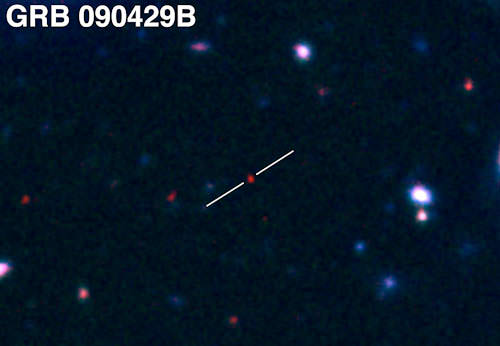[/caption]
You don’t have to be an old hippie… all you have to do is be able to picture a time within about half a billion years after the Big Bang. Thanks to a set of composite images taken by Gemini Observatory North telescope through different optical and infrared filters, science may have discovered what could be the most distant gamma ray burst (GRB) ever detected.
“Like any finding of this sort there are uncertainties,” said the study’s principal investigator Antonino Cucchiara. “However, if I were in Vegas, I would never bet against the odds that this is the most distant GRB ever seen and we estimate that there is even a 23% chance that it is the most distant object ever observed in the universe.”
As we probe further and further into the most distant reaches of space, we’re virtually able to look back in time. Even though gamma ray bursts last only a matter of minutes and occur billions of light years away, their “afterglow” can last for a period of a couple of weeks, allowing instruments like the Swift satellite or large ground-based telescopes to detect them. According to Cucchiara, “Gemini was the right telescope, in the right place, at the right time. The data from Gemini was instrumental in allowing us to reach the conclusion that the object is likely the most distant GRB ever seen.”
If their findings are correct, this implies the light of the distant GRB left from its source some 13.1 billion years ago or about 520 million years after the Big Bang. This allows astronomers to draw a conclusion that it is not the consequence of the very first generation of stars formed in the universe. The implication is that the early, extremely young universe was already a busy star factory.
“By looking very far away, because the light takes so long on its journey to reach the Earth, astronomers are effectively able to look back in time to this early era. Unfortunately, the immense distances involved make this very challenging. There are different ways of finding such objects, looking at distant galaxies being the most obvious, but because galaxies are faint it is very difficult. GRB afterglows are so much brighter”
But arriving at those type of conculsions isn’t easy and that’s why the study took two years to complete. “Ideally we would have gathered a spectrum to measure the distance precisely, but we were foiled at the last minute when the weather took a turn for the worse on Mauna Kea. Since GRB afterglows fade so quickly, we never got a second chance,” said Derek Fox, Cucchiara’s advisor for his graduate research at Penn State University.
Being sure enough to report findings as conclusive can be a tricky business. As with all things astronomy, a second “opinion” is not only welcomed, but a neccessary part of any findings. That’s why Gemini North’s images were combined with wider-field images from the United Kingdom Infrared Telescope (also on Hawaii’s Mauna Kea). As a result, the team was able to estimate the redshift of GRB 090429B with a high degree of confidence.

“The fact that we were never able to detect anything in the spot where we saw the afterglow in the Gemini data gave us the missing link in converging on this extremely high redshift estimate,” said Cucchiara. “We looked with Gemini, the Hubble Space Telescope and also with the Very Large Telescope in Chile and never saw anything once the afterglow faded. This means that this GRB’s host galaxy is so distant that it couldn’t be seen with any existing telescopes. Because of this, and the information provided by the Swift satellite, our confidence is extremely high that this event happened very, very early in the history of our universe.”
Really far out…


z=9.4 (approx) for those who prefer a different distance measure. The original paper can be found at: http://www.science.psu.edu/news-and-events/2011-news/Derek%20Fox%20Paper%2011%20May.pdf
I illustrated here on UT how an object observed with a z > 1 is on a frame that is being co-moved by the dynamics of space faster than light
http://www.universetoday.com/85816/galex-confirms-nature-of-dark-energy/
The cosmological horizon is at d = sqrt{3/?} ~ 10^{10}ly. The de Sitter scale factor in a linear approximation defines a velocity v = Hd, for H = 74km/sec/Mpc. The velocity v = c occurs at the cosmological horizon. In this linear approximation with v =~ 9.4c and we expect this distance to be 94 billion light years. Yet in fact the linear approximation is breaking down. The distance is given by a logarithm of the (a’/a)^2 (times other stuff) and so these galaxies are at about 2d, d = cosmological horizon distance. This is how the CMB turns out to be about 46 billion light years out, but occurring at 13.7 billion years ago.
LC
“very, very early”.
Figures, too early and I can’t keep track of all my zzz’s either. I’m glad we don’t have to run up against very, very, very early here. =D
But yeah, it is “a long time ago, in a host galaxy far far away” awesome.
Need to start working on getting a better telescope to get more clear images! D: